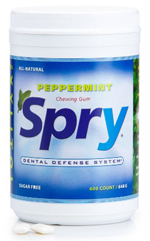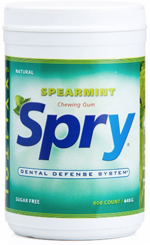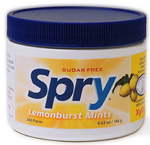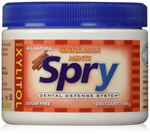Preventing Cavities in Baby Teeth
As a family that focuses on natural health, stressing prevention rather than intervention, we have been known for avoiding doctor visits as much as possible. We don’t do “well baby” visits since every time we did, the baby would end up sick. Since we don’t vaccinate, there really is no sense in making a yearly trip to the doctor. I can check my children’s height and weight just as well as the doctor can. And I don’t have to pay $80 to listen to untruths such as what to feed my baby or that children don’t need vitamins. Unfortunately, this feeling against the mainstream medical establishment carried over into our oral health, which proved to back fire in a big way. I will explain; and then I will tell you everything you need to know to properly take care of your children’s teeth. (What if my child already has a cavity?) (What if my child has braces?)
Teeth are Not Dead
Since teeth are considered dead, similar to hair, we often don’t think of them as living, breathing, well, not really breathing, but living things nonetheless. But they are. Just as having poor health can affect our teeth, so can poor teeth affect our health. This is especially true for little ones who have developing immune systems which are simultaneously fighting off all kinds of new viruses and bacteria. This is why it is important to monitor what’s going on in our children’s mouths, before we visit the dentist! What many of us don’t understand, at no fault of our own, is what causes cavities and how to prevent them. Let’s face it- dentists are not about keeping us cavity free, but they are ALL about filling our teeth. So we can’t depend on dentists to educate us on the best way to take care of our teeth. The most we get from them is, “brush at least twice daily, stop eating so much candy, and come to see me twice a year.” If that is the extent of your oral health education, you are not alone!
What Causes Cavities?
Contrary to popular belief, cavities are not caused by sugar. They are caused by bacteria. Bacteria just happen to LOVE sugar, and consuming it creates an acid, which eats away at enamel, eventually leading to a cavity. There are two important facts you should gather from this statement.
- Bacteria doesn’t have to have “sugar” in which to survive and multiply. Chips, bread, juice, and milk are not typically considered as evil as candy and other junk food, but that is where they get you! They are sneaky sugars that slip in and attack when defenses are down!
- Keeping bacteria at bay is a good way to help cut back on acid producing, enamel eating “Sugar Bugs.” So is keeping sugar intake to a minimum.
There is also a strong view that sugar in the diet leads to nutritional deficiencies, which lead to bad teeth. In any case, sugar should be avoided as much as possible! As a parent of young children, I do recognize the complexity of keeping the mouth not only bacteria-free, but also free of junk! It is the never-ending battle, but a battle that must be fought. You see, I was not the best warrior for my children’s teeth. I slept through the battle, and I will regret my neglect for a long time- at least until their extracted teeth grow back! My first child got his first tooth at 3 months. By 10 months he had 10 teeth! When he was 19 months, his sister appeared. The next 6 months are a blur! (Where does the time go?)
When Oral Health is Neglected
My daughter woke up one day with a dark tooth at 18 months, but we still hadn’t made our first trip to the dentist. The next thing I knew, my son was 4 years old and had some tooth pain. It was the week we were relocating from Georgia to Kansas, but we couldn’t stand to let our son be in pain, so we finally made the trip to the local dentist. On the painful tooth, he needed a pulpectomy and crown. The dentist said there were other teeth that would need work and that we should find a dentist as soon as we got settled in Kansas. The crown was about $450, I believe, but even worse than that was the experience. I found out through my son’s screaming that sometimes a root is so dead that it does not “take” the pain medicine. It was a nightmare. It was over probably much quicker than it felt, and my son got over it much faster than I did. I don’t think I will ever be the same! Six months later, we still hadn’t made our much needed appointments at the dentist, and while on vacation at the beach, my daughter announced to me that her tooth was loose. My son had lost two teeth already, just after he turned 5, so I immediately thought she just wanted to be like him. And then she showed it to me.
Five days later, the dark tooth fell out. It was one of the front
teeth on top. It was time to go to the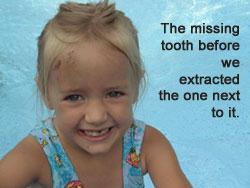 dentist! My first word of advice with children is to make your
appointment with a pediatric dentist. The regular dentist was a complete
waste of time. I know not all experiences will be the same, but I stand
by that statement. Once we got our appointment with the pediatric
dentist, it was decided right there on the spot that they would clean my
daughter’s teeth, and if she handled it well, they would numb the other
front tooth and extract it. It had a cavity (which the one that fell out
had, leading to the tooth dying) and the dentist preferred symmetry in
these cases so that the teeth coming down will come down evenly. My
daughter was only 3 ½! But I was okay with it. And she did great.
dentist! My first word of advice with children is to make your
appointment with a pediatric dentist. The regular dentist was a complete
waste of time. I know not all experiences will be the same, but I stand
by that statement. Once we got our appointment with the pediatric
dentist, it was decided right there on the spot that they would clean my
daughter’s teeth, and if she handled it well, they would numb the other
front tooth and extract it. It had a cavity (which the one that fell out
had, leading to the tooth dying) and the dentist preferred symmetry in
these cases so that the teeth coming down will come down evenly. My
daughter was only 3 ½! But I was okay with it. And she did great.
The dentist took a peek into my son’s mouth, and we set up an
appointment for the following week so that he could get a cleaning.
After the horrible experience he had already had, it was key to get him
comfortable with the dentist so that he didn’t think every trip would be
painful. It took a while to get through the cleaning because I had to
coax him every step of the way. Thankfully, his sister had
 already
survived a cleaning AND extraction, and he figured if she could, so
could he!
already
survived a cleaning AND extraction, and he figured if she could, so
could he!
The next week, he had the needed work done: under IV sedation, he had 3 pulpotomies, 7 crowns, a few composite fillings, and the top two teeth extracted. We also went ahead and had the two fully erupted 6 year molars sealed. The work and sedation ran about $2600. Sadly, because we neglected to educate ourselves about dental care, our son had to endure this, and it cost us more money than regular dentist visits would have!
Where did we go wrong? Believe it or not, our story is not very rare. It is hard to believe the stories I’ve heard from parents of babies as young as 12 months who already have cavities. There are very vigilant parents whose babies and children suffer similar fates, so I guess I shouldn’t be so hard on myself. But there are things not well-known in the mainstream world that you can do to help improve your child’s dental health.
Steps for Cavity Prevention
Update 2015: I am adding this to the top of the list because it is THE most important thing to know when it comes to kids and their teeth. I have figured this out by trial and error... during your kids' growth periods (and especially the one including puberty), your kids' teeth are more at risk than ever for developing cavities. I don't know why I didn't realize this before, given my background and understanding of nutrition and how important good nutrition is to the whole body, but during growth periods, the body is using up the nutrition kids are putting into their bodies for GROWTH. Not only are they eating more (and often "filler," empty calories), their bodies use up everything they eat, and the teeth are the last to get what they need. Compare this to a nursing mom who goes without proper nutrition because the baby gets all the good stuff. So if your child isn't eating well and/or taking supplemental vitamins during periods of growth, that is the time s/he is most likely to develop cavities. Please remember this, and try to feed your child nutrient dense foods rather than foods that will just fill him up.
- As soon as your baby has teeth, wipe them clean after each meal. While breast milk actually contains natural cavity fighters, formula does not.
- Do not allow your formula fed baby to go to sleep with a bottle, unless you plan on cleaning his teeth with a wipe and tooth gel after he is asleep.
- If your baby uses a pacifier, brush it daily. Do not put her pacifier in your mouth and then into hers. Bacteria from your mouth will grow in her mouth. This is especially a no-no if you have cavity/gum problems yourself.
- As soon as your child’s teeth are close together, begin flossing daily. Both of my children had cavities in the middle of their front two teeth. A little flossing would have saved these teeth.
- Do use a toothpaste/gel which contains xylitol. You can begin using a baby gel as soon as the teeth come in when you use Spry Tooth Gel. You can learn more about xylitol and the many benefits it provides, especially when you use it to replace the sugar in your foods. Xylitol helps kill the cavity causing bacteria in your child’s mouth, and when replacing the sugar with xylitol, you are helping double-fold. (See more ideas for ingredients to use for brushing your child's teeth below).
- Do not use fluoride toothpaste or a fluoride rinse. You can make your own rinse with water and xylitol. If you have tried adult mouth wash containing xylitol, you probably realize it is too strong for most children. Instead, just put a teaspoon of xylitol in about a cup of water, and have your child swish it around and gargle for two minutes after brushing.
- Cut back on processed foods, chips, white bread, candy, and soda (you get the idea). Do not allow your child to walk around with a bottle or sippy cup, unless you put water in it. Constantly bathing your child’s teeth in sugary juice is a BIG no-no. A great candy alternative is a healthy xylitol product called Sparx. You can get it in Berry, Fruit, and Citrus. Once your child can chew gum, you can also add another xylitol product like Spry Fresh Fruit Gum. Do not use other “sugar-free” gums that contain artificial sweeteners in addition to xylitol. Artificial sweeteners should be avoided for other health reasons. A few years ago, I was on a road trip and kept some Sparx candy in my mouth for almost the whole six hour trip. On the way back home, a large piece of plaque which had accumulated near the back gum line of a front tooth just broke away from the tooth. I was eating the candy because it was good, but I accidentally proved to myself how effective xylitol actually is!
- Allow your toddler to brush his teeth, and then brush them yourself afterwards. Children need help until the age of 7 or 8. Twice a day is adequate, three times a day is even better. For toddlers, a battery powered toothbrush with an oscillating head works great since they can simply hold the toothbrush on different teeth and get a lot done that way.
- Examine your child’s teeth daily, looking for dark spots, holes, and chipped teeth. If anything looks “off,” call your dentist and make an appointment. It’s better to be safe than sorry! A small cavity is much easier (and cheaper) to handle than a large one that has been neglected.
- Good oral health starts from the inside. To keep teeth (and the rest of the body!) at their healthiest, feed your child healthy foods and don’t forget a daily multivitamin. ALL children need a daily vitamin/mineral supplement. Increase Vitamin D intake during fall/winter when sunshine exposure goes down. RDA levels are way lower than what children should be taking. Given along with a raw dairy diet, my kids finally got an "all good" dentist visit after supplementing with Vitamin D during fall/winter. (I gave them each 5,000 IU about 3-4 times per week.)
While you can probably see a lot of problems yourself with visual inspections, it is good to begin regular dentist visits when your child is 3. The dentist will not only be able to find problems that you did not, but a good cleaning will help ensure that plaque and tartar build-up are kept at bay. If you do not practice regular oral hygiene on a consistent basis, you will need to make a trip to the dentist even sooner. Once your child is comfortable with the “happy” visits, he won’t be afraid to go in when there is a problem tooth.
Finally, it is important for all parents to know that there are some things we attribute to tooth health which is actually bad for the teeth. If you push milk on your children because it is "good for your bones!" please know that we have been fed a downright lie by the milk industry. Pasteurized milk is horrible for you! My son drank a LOT of milk for 4 years before we learned (and acted on) this information. We now get raw dairy products from a local farm with grass fed cows that graze all day. And it is cheaper than store bought milk! For dietary information important to tooth development, we suggest Nutrition and Physical Degeneration by Weston A. Price, D.D.S. This is a must read for all parents, and especially parents who recognize that there are dietary changes we can make that will predict a better future for our children. We are producing sick adults or healthy adults TODAY. Which will yours be?
Treatment of Cavities
If your child already has cavities, you are in for a world of confusion if you ask questions or visit more than one dentist (which you should). Treating cavities is not as much science as it is experience, and different dentists will want to handle them different ways. Some children's teeth decay much more rapidly than others and will have to be treated immediately. Others can wait it out and see what happens. Excellent tooth care can actually heal or remineralize the tooth. But the most important thing to be wary of is what your dentist wants to put in your child's mouth.
Never agree to mercury fillings. Do not let your dentist's opinion on the safety of amalgam ("silver") fillings change your mind on this. There is an alternative which is referred to as "composite" fillings. They are slightly more expensive, but far worth it. To learn more about why you want to avoid mercury fillings, visit International Academy of Oral Medicine & Toxicology . You also should read A Mouth Full of Poison: The Truth about Mercury Amalgam Fillings by Dr. Myron Wentz. It is an eye opener that every parent should have before visiting the dentist. Remember, most dentists still believe that mercury is safe. Do not let them convince you of that!
There are other things that you can do when the cavity is not that bad. One is HealOzone, which is relatively new and not widely available yet in the US. This procedure must be done by a dentist.
Ingredients you can use to brush your child's teeth include coconut oil (with or without essential oils added), Bentonite clay, hydrogen peroxide, salt/xylitol dissolved in water, and any other homemade tooth powder or paste with natural ingredients. Anything without glycerin is better than toothpastes that contain glycerin and keep teeth from remineralizing. I like using Bentonite clay mixed with cloves sprinkled over my toothbrush. Then I squirt a little peroxide on the brush before brushing. This might be messy used on kids, but worth it in the end.
On top of these treatments, you will need to do everything you can to keep the bacteria out of the mouth. Following the prevention strategies above is imperative!
For more information, read Raising Kids With Healthy Teeth While Keeping 'Dental Dollars' In YOUR Pocket.
Photographic Proof That Cavities Heal!
What if My Child Has Braces?
A few months ago, my ten year-old son had braces put on his teeth. I blogged about it recently. Yes, this is the same child I write about above, who had extensive dental work done at the age of 5. He asked repeatedly for braces, and he really did need them, so I made a deal with him. If he would brush his teeth regularly and take care of them like he should, I would see about getting braces for him. He really brushed better than I'd ever seen him before. I'm sure you know already what happened. As soon as he got the braces on...it was a chore to get him to brush. I no longer had anything hanging over his head!
For the first three days, he was on pain meds because his teeth hurt so badly. He was miserable. Since I had an oral irrigator, and I remembered having braces when I was younger, I thought that using the oral irrigator to massage his gums would help relieve the pain. It worked pretty well. He was able to use it himself whenever he wanted.
My son is a little bit of an anomaly. At the age of ten, he already has all his permanent teeth in, including his 12-year molars. So all of his teeth are literally bumped right next to each other. It didn't take me long to realize (after trying to help him floss myself) that he was NOT going to regularly floss his teeth with the braces in his way. It is SUCH a pain! We tried Super Floss which has an end that can be strung under the wire, plus floss for close teeth and those further away, all on one strand of floss. It's a great product. But even with it, I know that daily flossing just isn't going to happen! So I have this fear that all my money for the braces will be flushed away when his teeth rot out!
Not so fast. Remember the oral irrigator? It is our best friend. If your child needs or has braces, I HIGHLY suggest getting one. One I came across recently is AwEsOmE for kids:
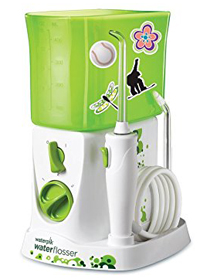 Waterpik Water Flosser For Kids
is geared for ages 6 and up, and comes with a special tip
for orthodontics. It
is clinically proven to be MORE effective than flossing! With
kids getting their hands on sweets and pop every time we turn
around, it's even more important that we provide them the tools
to remove it from their teeth. Another thing that I do is
inspect my son's teeth after he has finished brushing. If you
have not had braces, you may not realize how difficult it is to
remove food stuck in them. There are times when I have to send
my son back to the bathroom three times to re-brush. And it's
usually things like fruit fibers stuck in there, which is just
as bad as candy when left to feed the bacteria in his mouth. He
also uses Spry Oral Rinse.
I do not suggest this for younger kids, as the minty flavor is
pretty intense. I do suggest adding some Spry Oral Rinse to the
water in the water flosser. It just takes a "glug."
Waterpik Water Flosser For Kids
is geared for ages 6 and up, and comes with a special tip
for orthodontics. It
is clinically proven to be MORE effective than flossing! With
kids getting their hands on sweets and pop every time we turn
around, it's even more important that we provide them the tools
to remove it from their teeth. Another thing that I do is
inspect my son's teeth after he has finished brushing. If you
have not had braces, you may not realize how difficult it is to
remove food stuck in them. There are times when I have to send
my son back to the bathroom three times to re-brush. And it's
usually things like fruit fibers stuck in there, which is just
as bad as candy when left to feed the bacteria in his mouth. He
also uses Spry Oral Rinse.
I do not suggest this for younger kids, as the minty flavor is
pretty intense. I do suggest adding some Spry Oral Rinse to the
water in the water flosser. It just takes a "glug."
Anyway you will definitely want to buy the orthodontic tip for the water flosser. It has a tiny little brush on the end which helps remove debris from the brackets. (Make sure to purchase one for each child with braces.) Your water flosser will also come with stick on decals so your child can decorate it and make it his/her own.
Now you know everything you need to know about caring for baby teeth, and baby or permanent teeth with braces. Don't forget that caring for the teeth starts from the inside, where vitamins and minerals are very important! If you are interested in a vitamin/ mineral supplement designed specifically for your older child (9 and up) see Best Vitamins for Teens. Both of my children have moved on from chewables to one pill, and since many older kids don't like the chewables anymore, it is now easier to get into them what they really need!
Good luck with your child's teeth and I hope that you have found something here that is useful to you!
Raising Kids with Healthy Teeth While Keeping "Dental
Dollars" in YOUR Pocket




